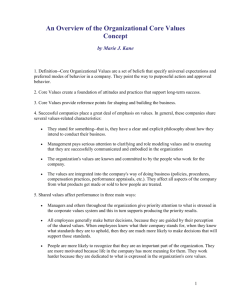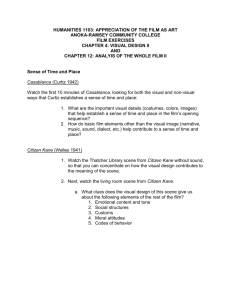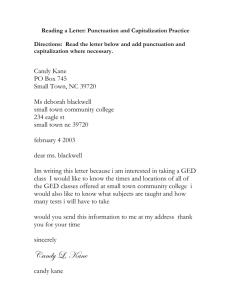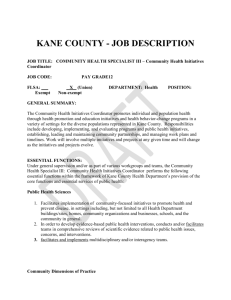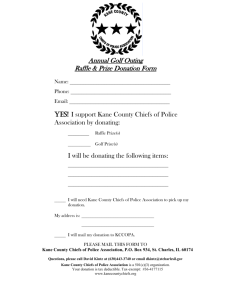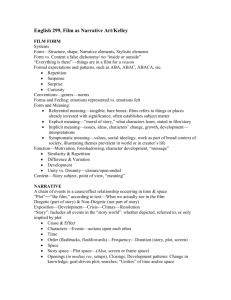Larsson`s notes, week 5.doc
advertisement
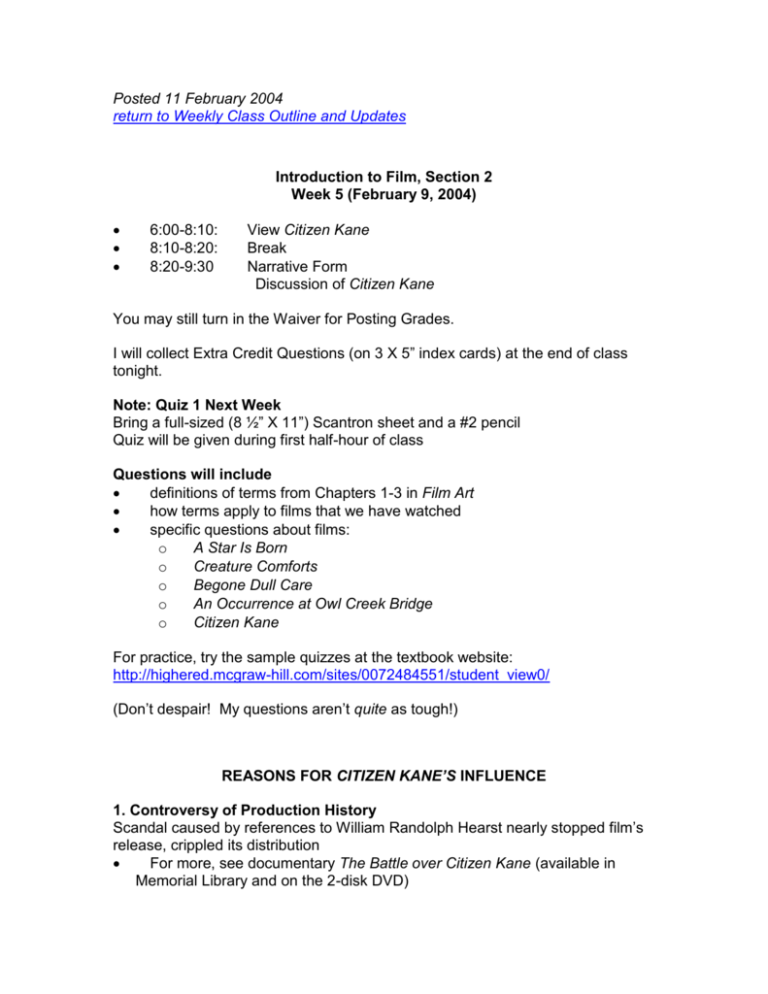
Posted 11 February 2004 return to Weekly Class Outline and Updates Introduction to Film, Section 2 Week 5 (February 9, 2004) 6:00-8:10: 8:10-8:20: 8:20-9:30 View Citizen Kane Break Narrative Form Discussion of Citizen Kane You may still turn in the Waiver for Posting Grades. I will collect Extra Credit Questions (on 3 X 5” index cards) at the end of class tonight. Note: Quiz 1 Next Week Bring a full-sized (8 ½” X 11”) Scantron sheet and a #2 pencil Quiz will be given during first half-hour of class Questions will include definitions of terms from Chapters 1-3 in Film Art how terms apply to films that we have watched specific questions about films: o A Star Is Born o Creature Comforts o Begone Dull Care o An Occurrence at Owl Creek Bridge o Citizen Kane For practice, try the sample quizzes at the textbook website: http://highered.mcgraw-hill.com/sites/0072484551/student_view0/ (Don’t despair! My questions aren’t quite as tough!) REASONS FOR CITIZEN KANE’S INFLUENCE 1. Controversy of Production History Scandal caused by references to William Randolph Hearst nearly stopped film’s release, crippled its distribution For more, see documentary The Battle over Citizen Kane (available in Memorial Library and on the 2-disk DVD) A fictionalized (and somewhat inaccurate) account is presented in the recent HBO production RKO 281 The best book on the subject is The Making of Citizen Kane by Robert Carringer (also available in Memorial Library) 2. Content and Narrative Form Are Somewhat Unusual for Time Theme that criticizes American “success ethic” Criticism of living, powerful man Complexity of flashback structure Somewhat open ending 3. Dramatic and Innovative Uses of Film Style Complex use of props and other elements of mise-en-scene to support narrative, suggest meanings Dramatic uses of low-key lighting Unusual uses of camera angles and extended camera movement Innovative development of “deep-focus” cinematography Use of overlapping dialogue and sound for emotional context Effect of Hearst Controversy on Welles and Citizen Kane RKO President George Schaefer replaced Control of The Magnificent Ambersons taken from Welles, ending is re-shot and re-cut, original footage destroyed Welles continues to work in theater and film but never has full funding and full control at same time again Kane earns critical praise but does not succeed at box office Kane is pulled from theaters, put on shelves at RKO, neglected and forgotten Re-released in early 1950s Acclaimed “greatest film” by international critics at Brussels World Fair Remains at top of “best films” lists ever since Indirect Influence on American Films Downbeat themes, complex narrative structures become more common by end of World War II Innovations in lighting, deep focus cinematography developed further Helped to spur development of film noir style in 1940s and 1950s (Film Noir: American films from late 1940s and 1950s labeled “black film” by French critics because of downbeat themes and dark passions in narrative, notable use of low-key lighting and extreme camera angles.) Direct Influence on Future Filmmakers and Critics Other notable Welles films: The Magnificent Ambersons The Lady from Shanghai Othello Touch of Evil Chimes at Midnight NARRATIVE FORM What is narrative? Chain of events linked by cause and effect moving in time and space Narratives may be Fictional Non-Fictional Presented in many formats (documentary, compilation, animation, commercials, public service announcements, etc.) Narrative form is presented through all of the elements of stylistic form mise-en-scene cinematography editing sound The total form or system of a film is made up of the interaction of its narrative and stylistic forms Example: Narrative form in A Star Is Born Follows general outline of common narrative pattern Exposition: Main characters are introduced Esther Granny Name of Norman Maine is mentioned Factors leading to later complications introduced Esther’s desire to become a movie star Causal event: Something happens to precipitate action Granny sends Esther to Hollywood Complications: Events impede action, add other factors Esther’s job hunt Meeting, love and marriage with Norman “Vickie Lester’s” success and Norman’s failure Intensification of action: Problems created by complications become more important and more vital Norman returns to drinking several times Vickie decides to quit the movies Conclusion: Problems are usually resolved, questions usually answered Norman’s death Vickie’s return Chain of Cause and Effect in A Star Is Born Cause: Esther reveals her desire to be a film star Effect: Granny sends Esther to Hollywood Cause: Effect: Effect: Effect: Effect: Effect: Esther looks for work Esther meets Danny at boarding house Danny gets job for Esther as waitress at party Esther meets Norman Maine face to face Norman is attracted to Esther Norman gets screen test and contract for “Vickie Lester” Cause: Effect: Effect: Effect: Vickie’s career takes off, Norman’s career slides Norman is laid off from studio by Oliver Norman resumes drinking Norman tries to “dry out” Cause: Effect: Effect: Effect: Effect: Effect: Effect: Norman meets and fights Libby at race track Norman goes on last binge Vickie vows to give up career Norman commits suicide Vickie plans to leave Hollywood Granny urges Vickie to stay Vickie resumes career (“Effects” in boldface also cause other events to happen) Characters cause events to happen Esther, Granny, Danny, Norman, Oliver, Libby Many films (but not all!) are character-driven STORY and PLOT in Narrative STORY All the events in a narrative, including what we assume or infer Events as they would have occurred in "real life" Total (imagined) story world is the film’s DIEGESIS (term goes back to Aristotle’s Poetics) PLOT Story events depicted by the film itself Events from the diegesis that have been selected and arranged within the film (or other narrative medium—novel, story, etc.) Includes nondiegetic elements ("mood" music, credits, etc.) The story elements of a narrative are conveyed by the plot The plot is conveyed by the stylistic elements of the medium Novels and Short Story: Comics and Graphic Novels: Theater: Opera and Musicals Film: Words, narration, dialogue Words and still images Words, mise-en-scene, performance Words, mise-en-scene, performance, music All of the above, plus cinematography and editing TIME IN STORY AND PLOT Elements of Time in Narrative: Order Duration Frequency Order--In what sequence do events occur? Story--Always in chronological order Plot--Often in chronological order, but not always Sequences can be reordered through flashbacks or flashforwards Viewers rearrange the time sequence into chronological order during and after the film Needed story information can also be provided through flashbacks, dialogue, voiceover or title narration, and other means Example: The Lord of the Rings trilogy uses flashbacks to show how the One Ring was forged, taken from Sauron, lost, and then found by Gollum Common Pattern: Plot opens in media res (“in the middle of the action”) Technique goes back at least to Homer’s Iliad and Odyssey Plot begins somewhere in the middle of the chain of cause-and-effect Usually requires some form of explanation of how the characters got to that point Examples of films that begin in media res: It’s a Wonderful Life, Star Wars: A New Hope, Master and Commander, Duration--How long do events last? Story--Events occur in "real" time (minutes, years, etc.) Plot—Usually manipulates story duration in some way o At least some events are usually left out o Events that do not advance the chain of cause and effect may be left in (“dead time,” scenes where “nothing happens”) but are usually omitted o Individual events may be slowed or speeded up by editing or cinematography (“slow motion” or “fast motion”) Screen--Actual running time of film o Events in story duration are usually shortened or omitted by plot duration to fit within the screen duration o Occasionally plot duration will be about the same as screen duration (High Noon, 12 Angry Men, Nick of Time, Time Code) Frequency--How often do events happen? Story--Each event is unique, occurs only once (but some events may have parallels or be part of a pattern) Plot--Individual events may be repeated by narrative as flashbacks or for different reasons Space in narration Locations, props, makeup, costume, etc. provide clues to temporal order, duration and frequency (changes in appearance, weather, seasons; use of clocks, calendars, etc.) Examples of Narrative and Time: A Star Is Born and An Occurrence at Owl Creek Bridge Order Story and plot are in chronological order in both films A Star Is Born makes verbal references to past events in characters’ lives (Granny going West, Norman’s earlier drinking) Occurrence begins in media res but does not explain how Peyton got caught and sentenced to hang (Ambrose Bierce’s story does!) Duration in A Star Is Born Story—Several years, including past events mentioned Plot—Presents events of a few of those years (2-4?) Screen—111 minutes Duration in An Occurrence at Owl Creek Bridge Story—About 5 minutes? Plot— Seems to be about 3 days Screen—28 minutes Peyton running to meet his wife in Occurrence is stretched out in screen duration through repetition and overlapping editing Occurrence is unusual in that the plot duration is longer than the story duration. Most of the “action” in the plot duration occurs within a few seconds of story time as Peyton’s body drops and the rope snaps tight! Frequency in A Star Is Born Each event occurs only once but individual events are given as part of pattern or to establish parallels Frequency in An Occurrence at Owl Creek Bridge Shots of Peyton’s wife rising at the beginning of the film (apparent flashback) and shots of her walking toward Peyton at the end are repeated NARRATION: How Information about the Narrative Is Given to Audience RANGE OF STORY INFORMATION How much does audience know compared to the characters? Unrestricted (Omniscient—“all-knowing”) Narration Viewers are given almost all important information Characters know only some of the information We know things before the characters do (can create suspense) Restricted Narration We know only what one character (or small group of characters) knows We discover information along with the characters (creates “surprise”) Most films mix unrestricted and restricted scenes in various ways UNRESTR----------------------------MIXED--------------------RESTR Range of Information in A Star Is Born Range in first half of film is largely restricted to what Esther/Vickie knows, with some exceptions (examples: she doesn’t see the landlord tear up her bill or Norman call Oliver on the night they meet) Second half of film shows more of what Norman knows (examples: the scene at the racetrack, Norman hearing Vickie say she’ll quit acting) Range of Information in An Occurrence at Owl Creek Bridge Range is highly restricted to what Peyton Farquahar knows Restriction is important to establishing surprise at end when we finally see what Peyton does not DEPTH OF STORY INFORMATION What kind of information is being given to the audience? Objective Information is presented by film as though by outside observer Facts are not in doubt (even if some facts are missing or turn out to be misleading) Subjective Information is filtered through character's sensory perceptions or thoughts Perceptual Subjectivity--We "see" through character's eyes (Point of View Shot) or "hear" through character's ears Mental Subjectivity--We have access to character's mental states: thoughts, fantasies, dreams, etc. Most films tend to be objective but mix in elements of perceptual and mental subjectivity Perceptual subjectivity is often used to reinforce the objectivity of the overall narration. Mental subjectivity may cast the objectivity of narration into doubt unless it’s accounted for in some way. Can create “unreliable narration.” Depth of Information in A Star Is Born Narration is mainly objective, objects and events are shown that some characters are unaware of Some examples of perceptual subjectivity (point-of-view shots) as characters look at objects or each other and we seem to “see” through their eyes No mental subjectivity (dreams, fantasies, etc.) is portrayed Depth of Information in An Occurrence at Owl Creek Bridge Depth seems objective, but gives hints that it is not Distorted sounds, closeups of insects, repeated running, etc. Revealed to be highly subjective—most of film is completely in Peyton’s mind NARRATOR Character or other agent who provides information in film Character Narrators: Granny telling Esther about how her own heart was broken Libby telling Oliver about Norman’s arrest Voiceover Character (Diegetic) Narrators: Character in the film recounts and comments on events, usually after the fact (“Joseph” in It’s a Wonderful Life, Photographer in The Last Samurai, Galadriel in The Lord of the Rings) Other Forms of Diegetic Narration (source is in “story world”): Esther’s letters to her grandmother The title on the film-within-a-film in A Star Is Born telling the audience that they are watching a preview of a film that has not been finished with editing Noncharacter (Non-Diegetic) Narrators (source not in “story world itself): Print— Description of “Hollywood—The beckoning El Dorado”—in A Star Is Born Excerpt of death sentence (in French) at end of Occurrence at Owl Creek Bridge Non-Diegetic Voiceover--Person who is not character provides information Filmmakers sometimes make a voiceover narrator’s status ambiguous— character in story world, or non-diegetic? The Classical Hollywood Cinema Pattern of storytelling established early in U.S. filmmaking (by 1915 or earlier) 1. Actions caused by individual characters with goals or desires 2. Characters encounter conflict in achieving goals 3. Characters or situations change because of conflict 4. Narration tends to be objective and less restricted (with exceptions). Degree of objectivity or subjectivity may be ruled in part by film’s genre 5. Events and film style strongly linked to chain of cause-and-effect, not just presented for own sake 6. Strong degree of closure: Most questions are answered, most problems solved, although there may be some loose ends A Star Is Born is a good example of this pattern! NARRATIVE IN CITIZEN KANE What Does “Rosebud” Mean? A sled What does sled mean to Kane when dying? Memory of childhood? But why? Questions not answered by knowing what Rosebud is: Why does Kane change? Does he really change? What did Kane really want from his life? Other props and setting elements suggest possible answers: Glass Globe—Snow reminds Kane of childhood, sled Statues, Art, Castles—Possessions that don’t mean as much as sled Jigsaw Puzzle—Rosebud is just “one piece” of the puzzle “No Trespassing” Sign— Indication of Kane’s wealth and status Suggests emotional distance that Kane keeps from others Suggests that some questions can’t be answered Role of Narrators in Citizen Kane Flashback structure creates mystery: What is Rosebud? Each narrator does not know but suggests answer or what Kane’s goal was: Thatcher: Bernstein: Leland: Susan: Raymond: To be “everything you hate!” Something Kane lost? Love, but none to return Love as power, control “He said a lot of crazy things” Depth of information from each narrator is objective, reinforces belief in facts of Kane’s life Range of information for each narrator is restricted to period when that person knew Kane best Thatcher: Bernstein: Leland: Susan: Unsympathetic character, never got along with Kane Most positive interpretation of Kane but more limited in how well he knew him Kane betrays ideals and personal friendship Used by Kane for own purposes Thompson is the means by which we learn what each narrator knows One exception to objective narration: Possible mental subjectivity in opening scene (falling snow Camera reveals information no one knows, especially at tend Narration and Time in Citizen Kane Plot time Begins with Kane’s death Follows Thompson as he interviews narrators Duration is about a week Takes story out of chronological order Story Order (Duration: “more than 70 years of a man’s life”) 1868 1871 1891 1898 1900? 1916 1918 1920? 1929 1931? 1935 1941 Mrs. Kane gets deed to mine Thatcher takes Charles back east Kane comes into inheritance, takes over Inquirer Kane finishes hiring Chronicle staff, fans war fever, tours Europe Marries Emily Runs for governor, divorced by Emily, marries Susan, Leland goes to Chicago Emily and son killed in auto accident (mentioned in newsreel) Susan’s opera tour, Kane fires Leland Stock Market crash, Kane forced to sell off assets Susan leaves Kane Kane tours Europe (“There’ll be no war”) Kane dies Story Order and Narrators in Citizen Kane NEWSREEL THATCHER BERNSTEIN LELAND 1868 1871 1891 1898 1900? 1916 1918 1920? 1929 1931? 1935 1941 Narrators’ segments overlap in story time, but each advances a bit further in Kane’s life. Multiple views form “jigsaw puzzle” without a final answer. Plot also manipulates frequency as element of time Newsreel depicts some of same events in other sections (Kane and Susan’s wedding) At least one event portrayed twice by human narrators: Susan’s opera debut SUSAN Citizen Kane and The Classical Hollywood Cinema Plot (Thompson’s search) does follow basic pattern: 1. Actions caused by characters with goals or desires Thompson wants to find out what “Rosebud” means Rest of film follows his search 2. Characters encounter conflict in achieving goals No one knows what Rosebud is 3. Characters or situations change because of conflict Thompson accepts his failure and goes home: “I don’t think any word can explain a man’s life” 4. Narration tends to be objective and less restricted (with exceptions) No reason to doubt facts that narrators tell (but they may be incomplete) Thompson winds up knowing more than any one narrator 5. Events and film style strongly linked to chain of cause-and-effect, not just presented for own sake Exception: film style calls attention to itself in camerawork, lighting, etc. 6. Strong degree of closure: Most questions are answered, most problems solved, although there may be some loose ends Kane is dead Thompson accepts failure and goes home Rosebud is revealed to audience, but meaning remains unclear Story (Kane’s life) does not conform to pattern: 1. Actions caused by characters with goals or desires Actions are caused by Kane, but his motives are unclear 2. Characters encounter conflict in achieving goals Kane creates most of conflicts he experiences himself 3. Characters or situations change because of conflict Kane may have changed a great deal but exact reason is not clear Kane may not have changed at all 4. Narration tends to be objective and less restricted (with exceptions) No reason to doubt truth of events, but some parts of Kane’s life are left unrevealed 5. Events and film style strongly linked to chain of cause-and-effect, not just presented for own sake Exception: film style calls attention to itself in camerawork, lighting, etc. 6. Strong degree of closure: Most questions are answered, most problems solved, although there may be some loose ends Kane is dead Not clear that he has learned anything from his life Meaning in Citizen Kane Referential Refers to historical events of past century (Spanish-American War, World Wars I and II, Great Depression, etc.). Audience would have experienced most of these Strong parallels between Kane and William Randolph Hearst Similarities between Kane and other self-made millionaires (Robert McCormick, Samuel Insull) References to media barons implies criticism of wealth, media power Thompson’s news agency similar to Time-Life, Inc. “News on the March” similar to “The March of Time” newsreel Newsreel narration is in “Time-ese” backward sentence constructions (“Mightier than the Pharoahs was Charles Foster Kane!”) Thompson and colleagues are anonymous figures in corporate newsgathering machine (remain in shadows) Explicit Thompson’s narrative: “I don’t think any word can explain a man’s life” (People are too complex to be defined by a single word) Reinforced by “No Trespassing” sign at beginning and end Kane’s narrative: No clear explicit message Implicit Money can’t buy happiness Power corrupts (maybe) Wealth and power should not be used for individual goals Kane’s (and Hearst’s) style of “yellow journalism” has been replaced by new media Symptomatic Women (Emily, Susan) defined by relationship to men but male power is shown as reason for much of their problems Criticizes American success ethic, abuse of wealth and power Only criticizes abuse, not system of journalism or capitalism, suggests need for reform of individuals, not major social changes Return to top
